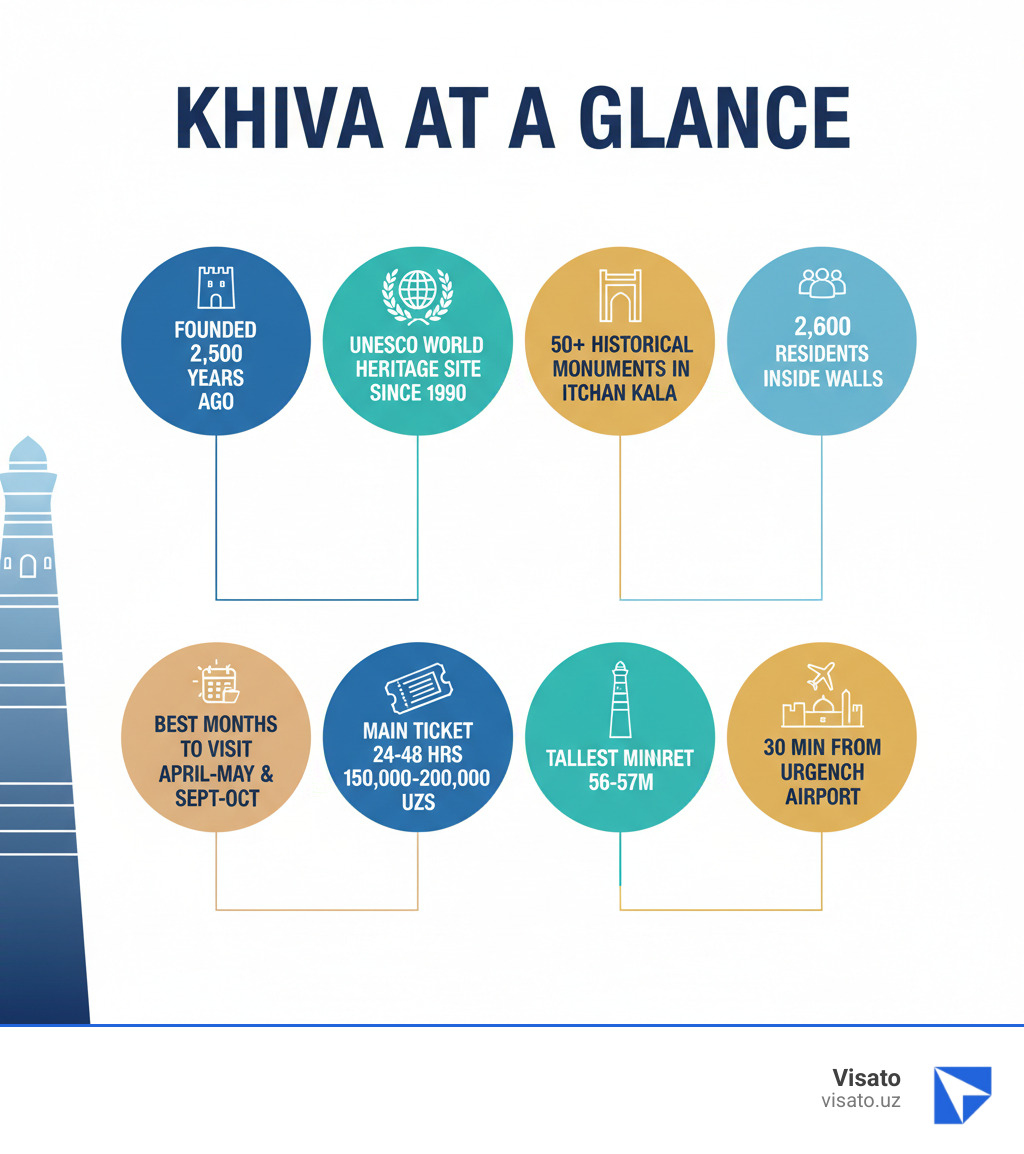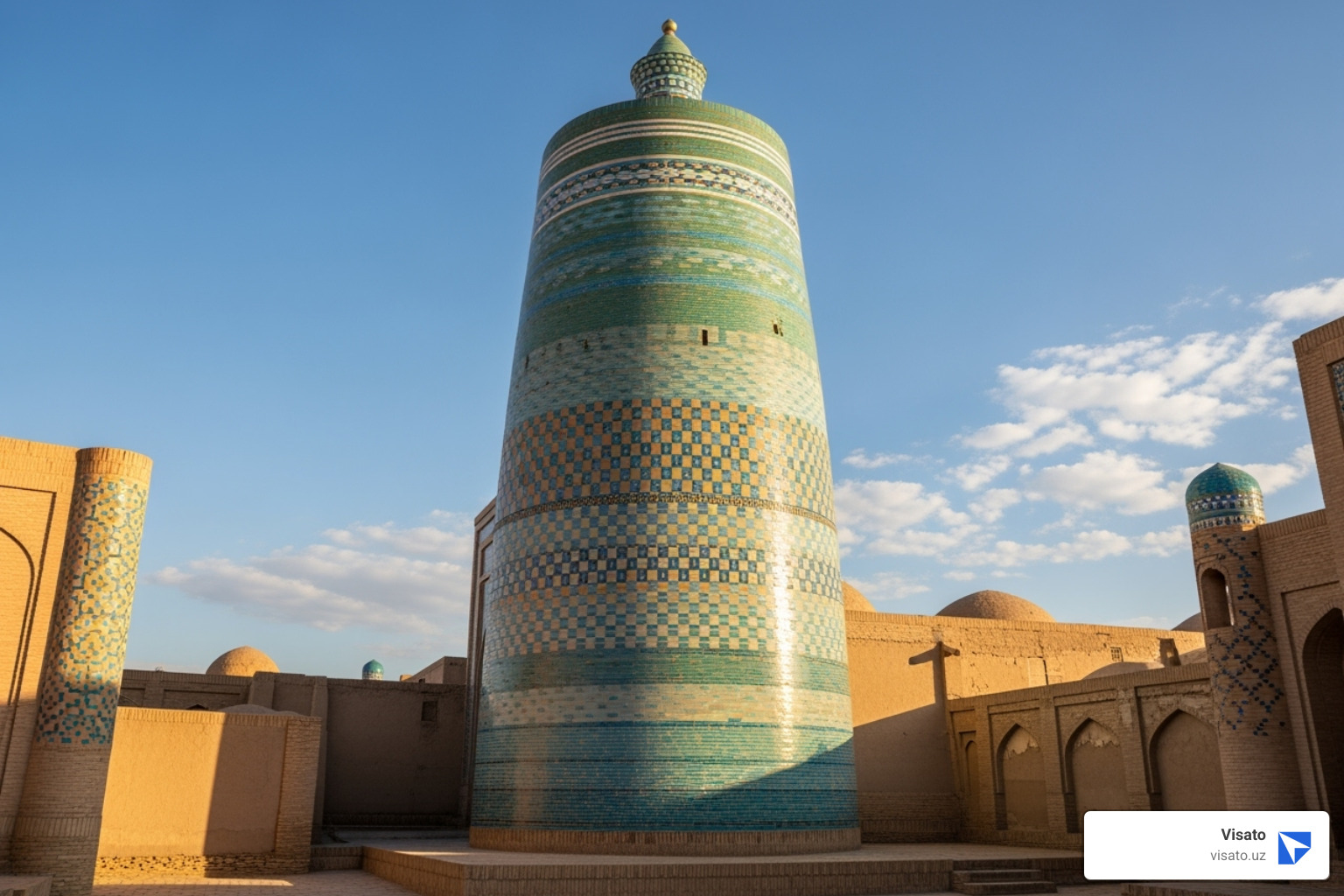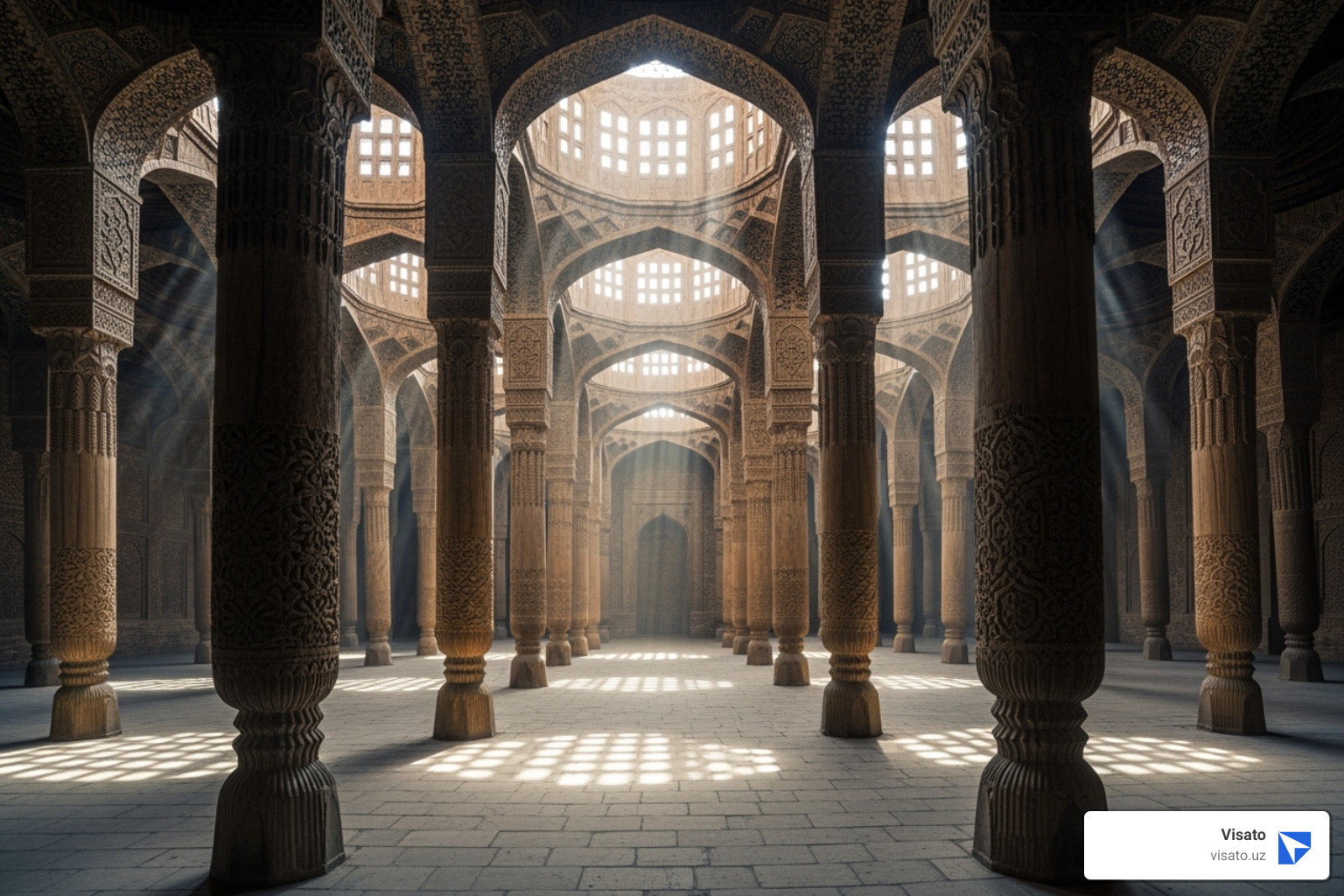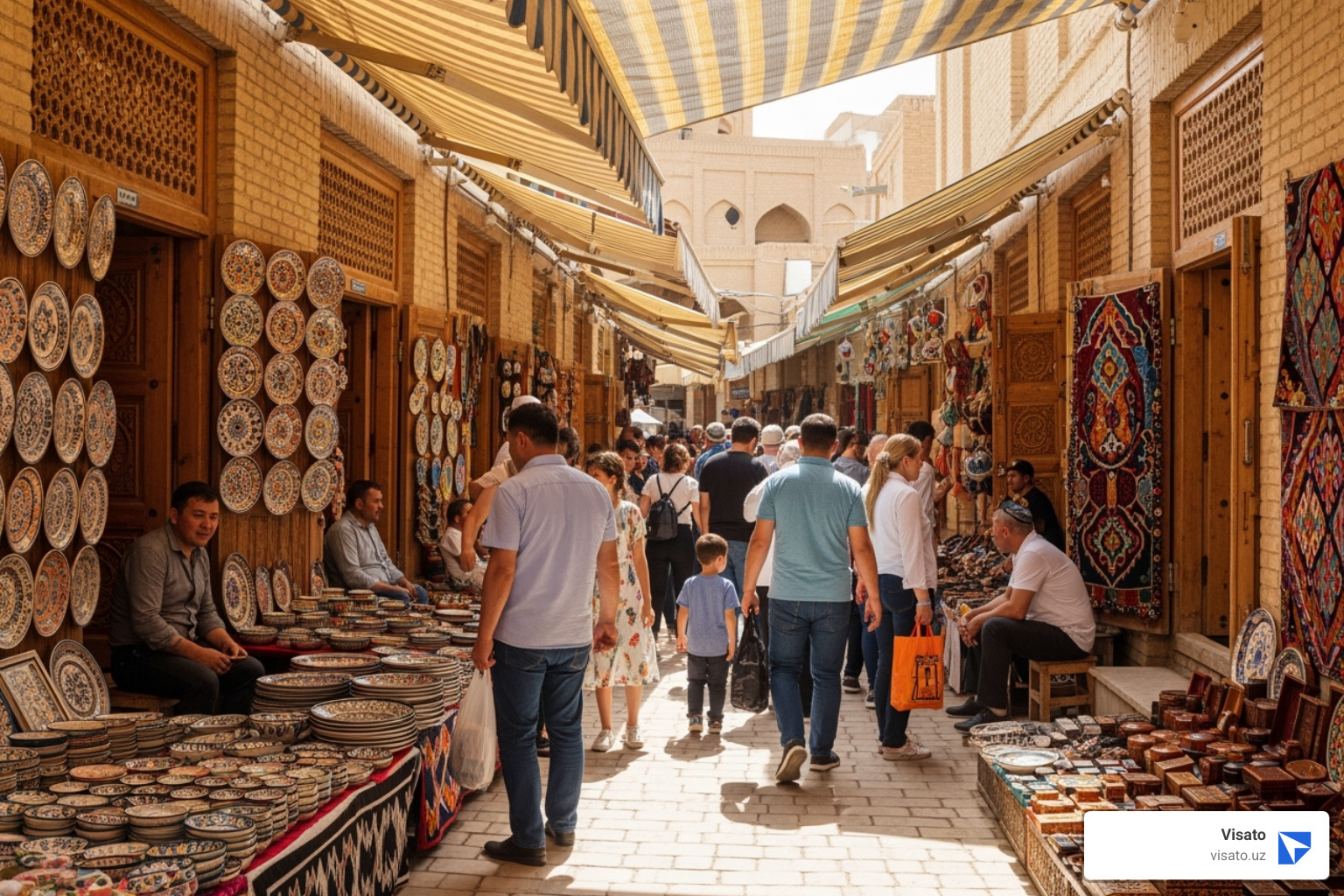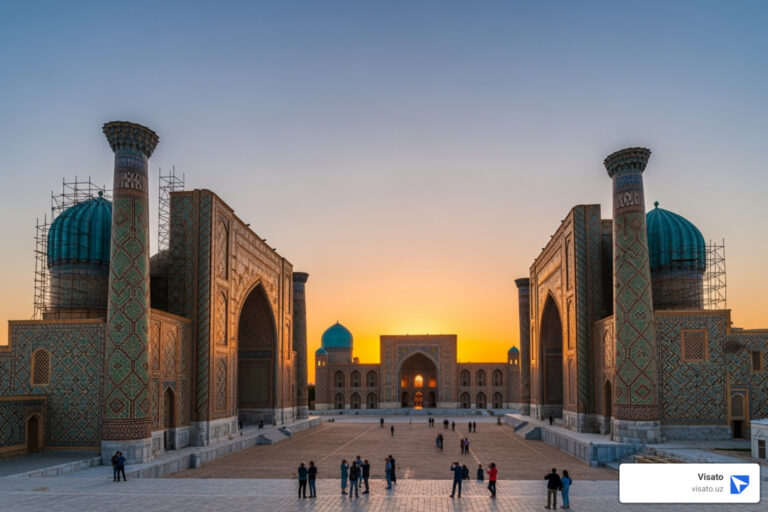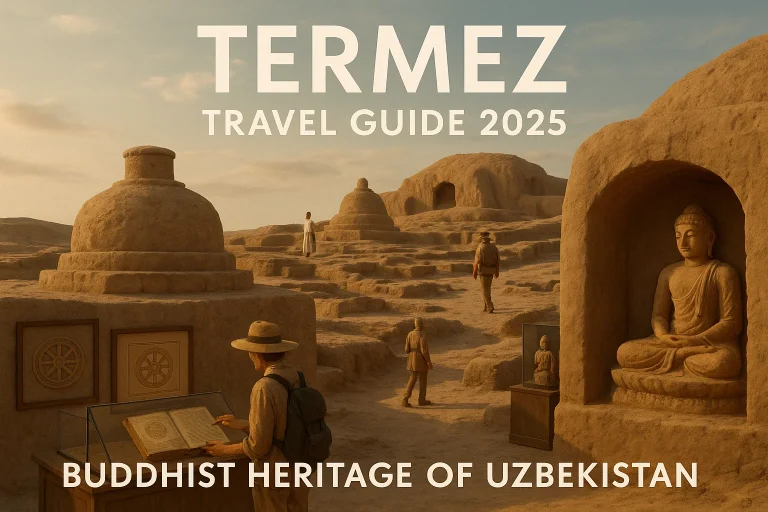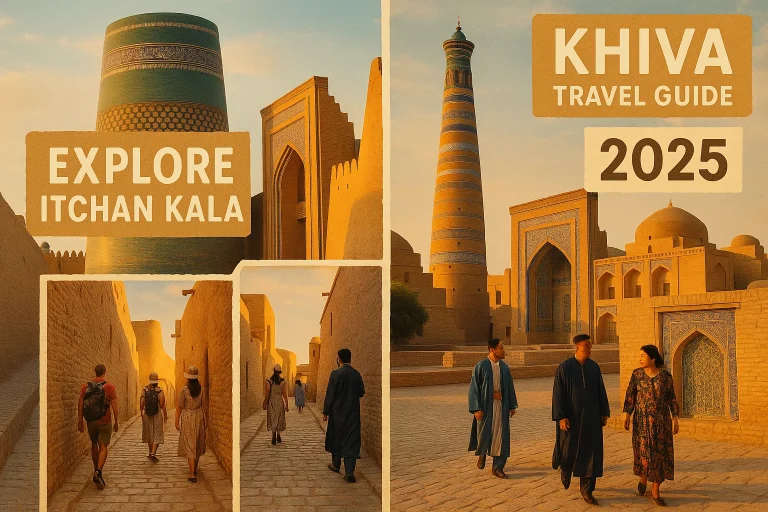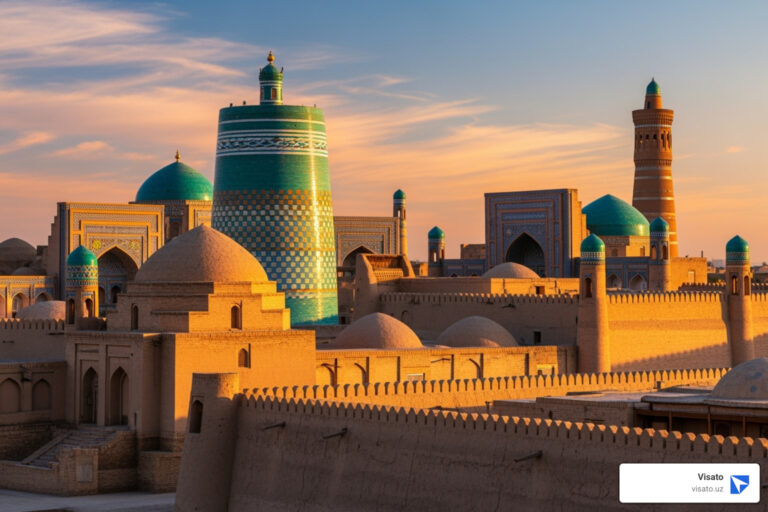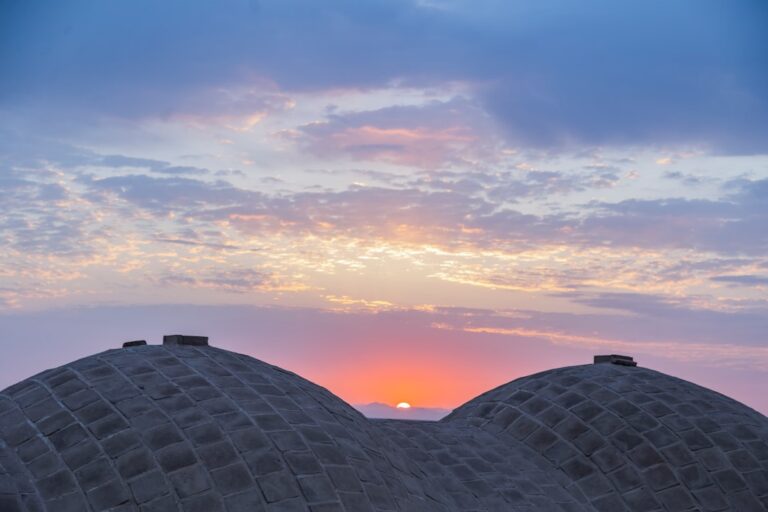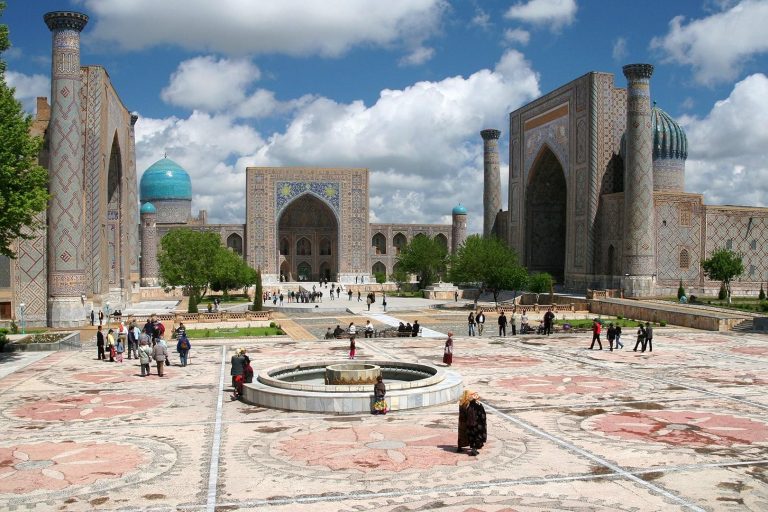Why Khiva Stands Out Among Central Asia’s Ancient Cities
Khiva tourist attractions offer a rare travel experience: a perfectly preserved medieval Silk Road city where history feels alive. This remote Uzbek oasis delivers an experience that travelers describe as stepping into another era.
Top Khiva Tourist Attractions at a Glance:
- Itchan Kala – UNESCO-listed walled city with 50+ historical monuments
- Kalta Minor Minaret – Iconic unfinished turquoise minaret (29m tall)
- Islam Khoja Minaret – Uzbekistan’s tallest at 56-57m with panoramic views
- Juma Mosque – Unique design with 213-218 ancient wooden columns
- Pahlavon Mahmud Mausoleum – Ornate tomb of Khiva’s patron saint
- Kuhna Ark – 12th-century fortress with sunset watchtower
- Tash Khauli Palace – Lavish royal residence with 150+ rooms
Located 1,000 km from Tashkent, Khiva was named the 2024 Tourism Capital of the Islamic World. Its 26-hectare Itchan Kala walled city houses 2,600 residents among monuments dating from the 14th to 19th centuries, creating a true open-air museum.
The city presents a paradox: some find its restored buildings feel like “artificially constructed film sets,” while others see it as Central Asia’s most authentic Silk Road experience. Regardless, Khiva consistently surprises visitors who make the journey.
I’m Nariman Huseynov with Visato. Over the past five years, I’ve helped thousands of travelers with their Uzbekistan plans. The journey to Khiva takes effort, but its concentrated, walkable collection of monuments simplifies planning once you arrive.
Why Khiva is a Must-Visit Destination
Khiva sits roughly 1,000 km from Tashkent, causing many travelers to stick with Samarkand and Bukhara. That’s a mistake.
Those who make the journey consistently describe Khiva as their favorite city in Uzbekistan, an “underrated masterpiece.” After helping thousands of travelers through Visato, I’ve heard it countless times: people almost skip Khiva, then wish they’d allocated more time there.
What makes Khiva so special? It’s a remarkably preserved medieval walled town. With 2,600 people living within the Itchan Kala fortifications, it feels more like a living museum than a roped-off tourist site.
In 2024, Khiva was named the Tourism Capital of the Islamic World, an award recognizing its historical significance and vibrant culture, often given to deserving but lesser-visited destinations.
The atmosphere is unique in Central Asia. While heavily restored, giving it a “film-set feel” to some, this preservation creates an immersive experience. The intricate tilework and mud-brick walls evoke the spirit of ancient Silk Road caravans.
Unlike Samarkand and Bukhara, which blend ancient and modern, Khiva’s entire historical core is contained within massive walls. This offers a concentrated journey through time, allowing you to explore the main Khiva tourist attractions without shifting between eras.
Travel logistics have also improved. Over 90 nationalities—including all UK and EU passport holders—now enjoy visa-free entry to Uzbekistan for up to 30 days. Planning your trip has never been simpler. For those who do need a visa, Visato.uz streamlines the process. You can apply for your Uzbekistan e-visa online, and our Uzbekistan e-visa guide and info on Uzbekistan e-visa requirements will help you prepare.
As National Geographic highlighted in its 6 reasons to visit Khiva, Uzbekistan, this remote oasis rewards the effort. The payoff is wandering preserved alleyways as the sun sets on turquoise domes, a sight that makes every kilometer worthwhile.
Finding Itchan Kala: A Tour of Khiva’s Tourist Attractions
Khiva’s heart is Itchan Kala, the UNESCO-listed inner walled city. This 26-hectare fortress is a living neighborhood where 2,600 people reside among the ancient architecture. It’s both an open-air museum and a home; while wandering past 50+ historical monuments, you’ll see daily life unfold. This unique blend makes exploring Khiva tourist attractions so memorable.
The Unforgettable Minarets of Khiva
Khiva’s skyline is defined by two distinct minarets.
Kalta Minor Minaret
The unmissable Kalta Minor Minaret’s name means “short minaret.” Commissioned by Mohammed Amin Khan (1852-1855), it was meant to be over 70 meters tall. Construction stopped when the Khan died in 1855, leaving a spectacular, stout tower 29 meters high. Covered in dazzling turquoise, blue, and white tiles, it has become one of Khiva’s most photographed attractions despite being unfinished.
Islam Khoja Minaret
Completed in 1910, the Islam Khoja Minaret is Khiva’s tallest structure at 56-57 meters. Climbing the 175 steep, narrow steps is not for the claustrophobic and requires an additional fee (7,000-100,000 som). However, the climb is worth it for the panoramic views of the walled city. The sight at sunrise or sunset, with golden light bathing the mud-brick walls and domes, is unforgettable.
Sacred Spaces and Grand Palaces
Beyond the minarets, Itchan Kala holds some of Central Asia’s most beautiful religious and royal buildings.
Juma Mosque
The modest exterior of the Juma Mosque hides a prayer hall filled with 213 unique, carved wooden columns. Rebuilt in 1788, the mosque incorporates pillars from as early as the 10th century, creating a timeline of craftsmanship. The low ceilings and soft light create a mystical atmosphere. Arrive early to avoid tour groups and appreciate this architectural marvel in the quiet morning light.
Pahlavon Mahmud Mausoleum
This ornate mausoleum honors Pahlavon Mahmud, Khiva’s 13th-14th century patron saint. Originally from the 1320s, it was largely rebuilt in the 19th century with its striking turquoise dome and intricate tilework. Inside, the sublime tilework is overwhelming. As an active pilgrimage site, visitors should dress modestly. Entry requires a separate fee (6,000-25,000 som), but the peaceful courtyard and beautiful interiors make it worth the cost.
Kuhna Ark
The Kuhna Ark (“Old Fortress”) was Khiva’s center of power. First built in the 12th century and expanded in the 17th, this complex housed a throne room, mint, mosque, and harem. The real treasure here is the watchtower. Climb up an hour before sunset for spectacular views over Itchan Kala as golden light washes over the city’s mosques and minarets.
Tash Khauli Palace
Tash Khauli Palace, or “Stone House,” is a lavish complex built between 1832-1841 with around 150 rooms. The famous harem housed the Khan’s five wives and 41 concubines. The decoration is striking, with blue ceramic tiles and carved wooden pillars. The sumptuous interior offers a vivid glimpse into the extravagant lifestyle of Khivan royalty. Visiting in the late afternoon can mean fewer crowds.
Lesser-Known Khiva Tourist Attractions and Experiences
Beyond the grand monuments, Khiva’s best moments are often found in its quieter corners.
Walking the City Walls offers a different perspective. The Outer Wall is open 24/7, with some sections accessible without a ticket. The sunrise or sunset views are spectacular.
The Khiva Silk Carpet Workshop, a UNESCO-partnered project, preserves ancient traditions. Watch artisans work silk from cocoon to carpet and learn about traditional techniques. The handmade products make meaningful souvenirs.
Our best advice is to explore the backstreets. Wander into the residential areas to find authentic local life unfolding among ancient walls. These quiet corners reveal Khiva’s true magic: a living city where history and daily life intertwine.
Practical Guide for Your Khiva Adventure
Planning a trip to remote Khiva is more straightforward than it seems. Here’s what you need to know for a smooth visit.
Getting to Khiva: Your Transport Options
Flying to Khiva
The quickest way is flying into Urgench Airport (UGC), a 30-minute drive from Khiva. Uzbekistan Airways offers 1.5-hour flights from Tashkent (around €100 one-way). A taxi from the airport is simple; confirm the price with your hotel beforehand (recent reports suggest ~450 SOM / €5), or ask them to arrange a pickup.
Taking the Train
For a scenic journey, take the train to Khiva’s station. Direct trains run from Tashkent and Bukhara. A first-class ticket from Tashkent is over 400,000 sums, while the 7-hour overnight sleeper from Bukhara starts around 146,850 SOM (€16.50). Book train tickets well in advance, especially during peak season, via the official Uzbekistan Railways website: Check train schedules and prices here.
Navigating Itchan Kala: Tickets and Tips
Khiva’s walled city is wonderfully easy to explore on foot.
Your Entrance Ticket
To enter Itchan Kala’s main Khiva tourist attractions, buy a ticket at the West Gate (Ota Darvoza). Prices vary, but as of 2024, expect to pay 150,000-200,000 SOM (€12-15) per person. Ticket validity can be 24 or 48 hours; confirm when purchasing. It covers most sites, museums, the city walls, and the watchtower, offering excellent value.
Extra Fees to Know About
A few sites require separate fees. Climbing the Islam Khoja Minaret (7,000-100,000 som) and entering the Pahlavon Mahmud Mausoleum (6,000-25,000 som) cost extra but are well worth it.
When to Visit
The best months are April to May and September to October, when temperatures are pleasant. Summer (June-August) is brutally hot (over 40°C/104°F), so explore early and late. Winter (November-February) is very cold (down to -15°C), making sightseeing difficult.
Where to Stay and What to Eat
Your accommodation choice shapes your experience.
Inside or Outside the Walls?
Staying inside Itchan Kala is magical. After day-trippers leave, you’ll have the ancient city to yourself. Guesthouses in converted madrasahs are steps from all attractions. The downsides are higher prices and fewer local amenities.
Staying outside Itchan Kala offers better value and a more authentic local experience, with affordable guesthouses and more dining options. The only downside is a 5-15 minute walk to the West Gate.
Our recommendation: If your budget allows, spend at least one night inside the walls for the atmosphere.
What to Eat
Khiva offers a chance to try regional specialties. Shivit Oshi is the signature dish—bright green dill noodles served with a stew. You’ll also find plov, the beloved Uzbek rice pilaf, everywhere.
Where to Eat
Terrassa Cafe’s rooftop offers stunning views of Itchan Kala. While pricey, it’s perfect for a tea break. Khiva Moon serves a good range of local dishes, including Shivit Oshi. Khorezm Art Cafe gets consistent praise for quality and value. Generally, restaurants outside the walls offer better value. Alcohol is usually available if you ask.
I’m Nariman Huseynov with Visato. Getting your visa sorted first makes planning much smoother. Our platform at Visato.uz simplifies the process: apply for your Uzbekistan e-visa online and get it in 2-3 business days, so you can focus on planning your trip.
Frequently Asked Questions about Visiting Khiva
Here are answers to the most common questions about exploring Khiva tourist attractions.
How much time do I need to see Khiva?
You can see Khiva’s main sights in one full day, as the city is compact and walkable. However, we recommend two days. This allows you to explore the backstreets, experience sunrise and sunset over the monuments, and absorb the atmosphere without rushing.
A three-day stay allows for day trips to the surrounding Khorezm desert fortresses. Extra time in Khiva rewards you with deeper memories.
Is Khiva safe for tourists?
Yes, Khiva is very safe for tourists, including solo female travelers and families. Tourist safety is a government priority, with tourist police present in Itchan Kala. Petty crime is rare; you’re more likely to encounter the famous Uzbek hospitality.
While normal common sense applies, major security concerns are not an issue in Khiva. You can relax and enjoy the experience.
What should I wear when visiting Khiva’s attractions?
Uzbekistan is a tolerant Muslim country, but modest dress is recommended to show respect and connect with the local culture.
For women, tops covering the shoulders and bottoms covering the knees are recommended. A lightweight scarf is versatile for covering your head or shoulders when entering religious sites like the Pahlavon Mahmud Mausoleum.
For men, shorts and t-shirts are generally fine, but long trousers are better for religious sites. Avoid wearing tank tops in these places.
Comfortable walking shoes are essential for everyone. You’ll be walking on cobblestones and climbing steep stairs, so supportive footwear is a must for exploring Khiva tourist attractions. Dressing modestly shows respect and can lead to warmer interactions with locals.
Conclusion
Standing beneath the Kalta Minor Minaret or watching the sunset from the Islam Khoja watchtower, you’ll understand Khiva’s unique charm. The Khiva tourist attractions within Itchan Kala are portals to another time, with echoes of the Silk Road in its alleys.
While remote, Khiva’s magic is preserved in its details: the Juma Mosque’s wooden columns, the Pahlavon Mahmud Mausoleum’s tilework, and the life unfolding in its backstreets. The city rewards those who make the journey.
What makes this desert city truly special isn’t just its accolades, but its living history. It’s a place where “open-air museum” and “living city” mean the same thing, found in interactions with weavers or watching children play near ancient walls.
Khiva consistently ranks among travelers’ most cherished memories. If you’re planning an Uzbekistan adventure, we can make the visa process smooth. Apply for your Uzbekistan e-visa online through our secure platform and receive it in 2-3 business days with 24/7 support. Explore our guides on the Uzbekistan e-visa for tourism or our Uzbekistan business e-visa options.
The ancient caravans crossed deserts to reach Khiva. Today, your journey is easier, but the wonder of stepping through those ancient gates is just as profound. We can’t wait to help you get there.

